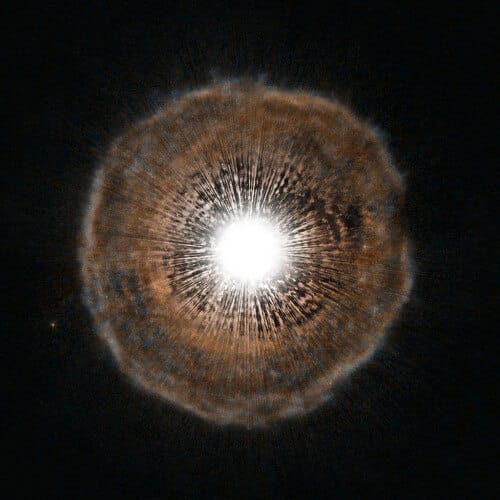The red giant U Cam, in the northern constellation Giraffe, exploded and released a nearly perfect spherical shell, a rarity in the chaos of star death

As stars reach their inevitable end they run out of stellar fuel and begin to lose the gravitational grip of their outer layers. These layers can be blown far into space in a huge gust of gas. Sometimes this phenomenon looks spherical, sometimes - when there are any disturbances - its shape is irregular.
In the case of the red giant in the picture this time it is a perfectly spherical shape. The star known as U Cam resides in the Camelopardalis group and was recently photographed by the Hubble Space Telescope.
U Cam is an example of a carbon star. It is a rare type of star whose atmosphere contains more carbon than oxygen. Due to the low surface gravity, usually about half of the total mass of the carbon star may be lost due to strong stellar winds. Its position in two years is near the North Pole star - U Cam itself is much smaller than it appears in the Hubble image. In fact the star will fit into a single pixel in the center of the image. However, its brightness is enough to saturate the camera's receptors and therefore the phenomenon makes it appear larger than it really is.
The gas shell, which is larger but paler than the parent star, is seen in detail in the Hubble image. While phenomena that occur at the end of a star's life are usually irregular and unstable, the shell of gas moving away from U Cam is almost a perfect sphere.
Read more: http://www.universetoday.com/96166/the-last-outbursts-of-a-dying-star

6 תגובות
What is the size of the star, what is its distance, what is the diameter of the gas ball you see in the picture. What is the speed of expansion of the ball?
These are important details without which the article has no value.
Father, please correct, third line to fly, instead of what is written.
let's make a toast to the useless higgs
How did they locate this star?
How long has this star been exploding?
Stunning
They had to HDR the image - that is, combine it with an image with a lower exposure level to reveal details in the center.